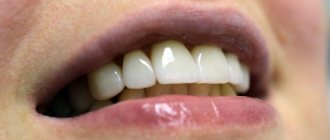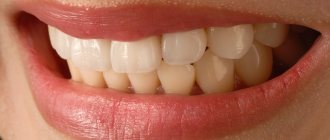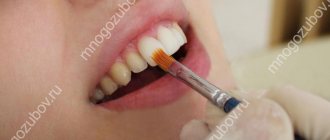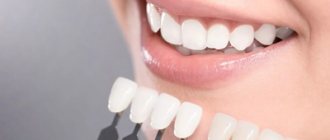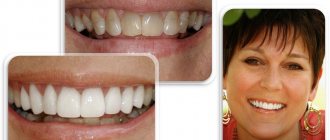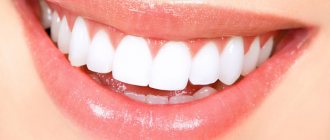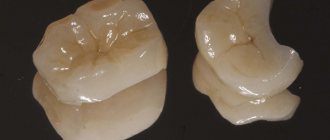To understand which veneers to choose, ceramic or composite, let’s take a closer look at what dental veneers are and what their features are. Veneers are thin plates of ceramic (sometimes zirconium) or composite material that are fixed to the front side of the teeth. Such microprostheses are used to correct aesthetic defects of the dentofacial apparatus and provide additional protection to the enamel. The onlays, made from impressions, imitate the natural shade of the dentition and do not stand out from it.
Veneering straightens the dentition, hides defects (uneven teeth, large interdental gaps, cracks or chips of the coronal shell), simplifies oral hygiene, and serves as an effective means of preventing periodontal diseases.
Author of the article: Meliksetyan Daniel Oganesovich
Work experience:
15 years
Specialization:
Dentist-orthopedist
Works:
at the clinic on Proletarskaya metro station
Composite veneers
Veneers
are microprostheses made in the form of a plate, installed on teeth to correct a cosmetic defect in one or all teeth. Allows you to correct the color and shape of natural ones. Cover the visible part of the tooth. Correct curvature, cover chips and cracks in enamel. The installation of composite veneers is carried out by a dentist, who makes them based on the structural features of the patient’s teeth.
The procedure is popular due to its excellent cosmetic effect: straight, white teeth improve your image and give you more self-confidence in everyday life. There are several types of onlays used by dentists to cover imperfections inside the mouth.
What to choose
The main advantage of composite restorations over porcelain structures is their lower price and the ability to reduce the time spent on their installation. However, this advantage can no longer be called relevant today, since technologies have appeared that make it possible to install ceramic overlays in a day.
Reviews from doctors and patients indicate that veneering eliminates dental defects, but composites are less able to imitate the natural shade and structure of the enamel. The disadvantage of composite onlays is their inaccurate fit to the tooth surface, which causes the accumulation of bacterial plaque, increasing the risk of developing caries and periodontal inflammation.
The choice of veneering type depends on the number of restorations planned, the need for additional treatment and other factors.
Composite veneers are an excellent solution for the restoration of 1-2 teeth. But if there are problems in the entire frontal area, it is better to install orthopedic ceramic overlays.
Direct composite veneers
Direct composite veneers
so called because they are installed in one visit.
They are made by the dentist in front of the patient from a composite mass, which in its composition is similar to filling material. Ideal for patients who need to correct a minor cosmetic defect. The dentist removes a thin layer from the enamel to prepare the onlays (0.3-0.7 mm), sometimes without touching the enamel at all. Several layers of material are applied to the tooth, which hardens under a lamp. At the final stage, the last layer is sanded and polished. Direct composite veneers
are convenient because the dentist makes them directly in front of the patient, adjusting them individually for each tooth. A tight fit of the plates to the surface is guaranteed.
Service life and care
Unfortunately, the service life of composite veneers is another aspect in which they are inferior to ceramic plates. Unlike the latter, which last for decades, composite overlays require renewal approximately every 4 years. In terms of care, in addition to the standard meticulous daily hygiene with a toothbrush, toothpaste, floss and irrigator, composite restorations also require periodic polishing. Therefore, you should not skip visits to the hygienist. There is no need to subject the pads to excessive mechanical stress: gnawing or biting anything with force. You can wear protective mouth guards at night to avoid accidental breakage. It is recommended to visit a doctor once every six months for a professional assessment of their condition.
Indirect composite veneers
Indirect composite veneers
are made in the laboratory by a dental technician from an impression taken from the tooth by the dentist. The overlay follows the exact shape, is selected according to color, and is sanded. Their properties are similar to composite ceramic veneers. During installation, the doctor applies slight pressure on the tooth for closer contact and a stronger connection. Suitable for installation in patients with serious problems that can be corrected with veneers. Installation is carried out on the second visit.
The plates made in the laboratory are more durable and natural compared to those made directly in the patient’s mouth.
Price question: how much does it cost to install veneers?
As we already said, dental veneers are not cheap, but they are worth it!
Approximate cost of microprostheses:
- Composite ones are the most budget-friendly. The cost of one unit is approximately 7 thousand rubles;
- Ceramic microprostheses, which are manufactured in a dental laboratory, cost approximately 20 thousand rubles per unit;
- Ceramic dental veneers made at the 32 Dent clinic will cost the patient about 15 thousand rubles per unit;
- Lumineers are the most expensive - from 50 thousand rubles per unit.
Indications for installation
The overlays restore the smile line, hiding flaws and imperfections. Indications for installation are:
- Incorrect placement of individual teeth, which can be corrected with veneers to create an even dentition.
- Darkening of natural enamel when professional whitening did not bring the desired result.
- The presence of an unaesthetic diastema.
- Unsightly, darkened fillings located on the necks of crowns.
- Tooth chip (if the loss of hard tissue was less than 60%).
- Enamel imperfections: cracks.
How to properly brush teeth with veneers and lumineers
There is nothing special here: in the morning before breakfast and in the evening after all meals using a brush (how to choose it - see the sign above) and paste. Complete the complex with the use of an irrigator, and finally rinse the mouth with mouthwash.
After each meal, it is mandatory to remove any leftover food. Preferably again with the help of an irrigator. It is important to maintain the condition of not only the veneers, but also the teeth underneath them, as well as the gums. Remember that even with dentures, teeth are destroyed - you can simply lose them.
Contraindications for installation
There are contraindications for installing veneers, which the doctor will identify after examining the condition of the oral cavity. The question is not about the skill of the dentist, but about the effectiveness and expediency of the procedure. You cannot install onlays if there is a dental problem that requires monitoring or is incompatible with the concept of veneers. The dentist’s task is to honestly tell the patient about the reasons he has discovered that prevent the procedure from being performed. Contraindications for installing veneers
from any material are:
- There are erosive changes in the enamel on the surface, as well as other defects that cannot be covered with veneers due to the impossibility of observing and treating them.
- Pathological abrasion of teeth, as well as their mobility.
- Impacted tooth.
- Dental diseases of teeth and gums, especially acute conditions. 5. Incorrect bite. 6. Bruxism.
- Poor hygiene.
- Bad habits (smoking, biting off hard objects).
- Short teeth.
- Pulpless teeth without nerves.
- Imperfect bite that can be corrected with orthodontic treatment.
- Participating in extreme or active sports that pose a risk of injury.
Pros and cons of ceramic veneers
The advantages of silicon oxide overlays are obvious:
- Lack of ability to oxidize, change color, or degrade. Ceramic veneers do not absorb pigments from food and do not disintegrate under the influence of acids and alcohols. They will not show any stains or discoloration throughout their entire service life.
- Ceramic veneers will last for more than a decade if initially installed correctly and handled with care.
- The plate is very durable, despite its microscopic thickness, not reaching even a millimeter.
- Imitation of enamel is the best among other veneering techniques.
Flaws:
- The cost of ceramic veneers is not affordable for every patient.
- The impossibility of quick prosthetics sometimes becomes extremely difficult. A person will have to visit the clinic at least twice: to take impressions and for final installation. In addition, you will have to spend money on making a temporary structure, which will need to be worn until the permanent veneers are glued.
- When preparing teeth for veneers, the doctor may overheat the tooth pulp, which can lead to inflammation and acute toothache.
Porcelain veneers require grinding down of the teeth. Composite veneers do not have high strength and durability. There is a better alternative to all options: install veneers without grinding your teeth Luxneers
Installation of composite veneers
- Examination of the oral cavity.
- Cleaning teeth from plaque and stones.
- Removal of caries.
- Selection of veneer shade. An important step if it is installed to close a defect on one or two teeth.
- Preparation of dental tissues before installation. Only the front surface is processed.
- For the indirect method at this stage: an impression is taken from the prepared tooth, the doctor will use it to create onlays, and the patient is fitted with temporary onlays that protect the enamel of the prepared teeth.
- Brushing teeth and applying acidic gel to treat the surface for better adhesion.
- Application of adhesive material to the front surface of the teeth.
- The onlay is attached with glue, pressed slightly and the dentist uses a lamp to harden the structure.
- Checking adhesion, removing unnecessary parts, connecting cement.
- Processing the lining, checking strength, smoothness, grinding and polishing.
Types of veneers for teeth: an overview of the characteristics of onlays made of different materials
There are many types of dental veneers. The classification of linings is mainly carried out according to the material of manufacture. Below we will consider different types of structures and their main characteristics.
Composite veneers
This type of dental veneers is also called direct or therapeutic. Direct veneers made from composite materials are called because they are applied in layers on the surface of the teeth and the procedure is carried out directly in the patient’s oral cavity. Installation of this type of microprosthesis is the fastest way to install veneers. It is possible to carry out the restoration procedure in just one visit to the dental clinic.
When replacing teeth with veneers, materials are used that are similar in properties to photopolymers used for fillings. This type of dental veneers has the most affordable cost, but at the same time it is the most fragile and short-lived. The overlays can change their attractive color under the influence of external factors, break under the influence of chewing load, and their maximum useful life is no more than five years.
Componeers
Componeers are a type of composite veneers. They are also used to correct aesthetic dental defects, but have a different manufacturing technology. Componers are not applied in layers - they are made using templates and then installed on the dental surfaces. Composite veneers are made from pressed composite material and are therefore more durable than conventional straight veneers. Their average service life is up to seven years.
It is worth noting that the installation of composites does not require preliminary grinding of tooth enamel.
Ceramic veneers: description and photo
Microprostheses of this type are the thinnest plates made from high-quality dental ceramics. The maximum thickness of a ceramic veneer is 0.5 millimeters. Ceramic veneers are installed using the indirect method, that is, first an impression is taken from the patient’s teeth, then microprostheses are made from it in the laboratory, and only after fitting the plates will be fixed to the dental surfaces using a special adhesive solution.
Ceramic veneers on teeth do not stain from contact with coloring foods and drinks, do not deform under mechanical stress, and have a color and pleasant shine identical to natural teeth. These characteristics of veneers on ceramic teeth provide an impeccable result of artistic restoration.
Can I use dental floss?
There are no clear prohibitions on the use of dental floss and interdental brushes, but you need to be extremely careful when using them. After prosthetics, microgaps between teeth are naturally preserved. But here it is very important not to move the thread from the gums to the edges (i.e., not to make vertical movements) - of course, not immediately, but gradually due to such actions the lining can be damaged. If you want to use floss, insert the tip not from below (from the cutting surface), but directly into the area between the teeth in the gum area - into the largest gap. After cleaning, remove it in the same way.
The same with brushes - when you remove them from the interdental space, be extremely careful. Choose the thinnest brushes. And best of all, buy an irrigator. This is an excellent replacement for both dental floss and brushes.
“Pay special attention to the condition of the gums, especially where the mucous membrane comes into contact with the edge of the veneer or lumineer. Due to tissue injury, inflammation may occur, which will lead to the fact that the pads will have to be removed for treatment, or due to a violation of aesthetics. For example, if gum recession begins and the roots of the teeth become exposed.”
Dzhutova Aida Vladimirovna Implant surgeon, periodontist Work experience more than 9 years make an appointment
Do you dream of a beautiful smile? We have developed COMPLEXES of veneers for the smile area - place 4, 6 or 12 onlays at once! Save up to 30 thousand rubles and get a Hollywood smile!
sign up now
Types of procedure
The choice of dental restoration technique depends on the individual characteristics of the clinical case. The following factors are taken into account: location of defects, extent, severity. Common types of restoration:
- Veneers. Restoration of the front teeth with composite material is carried out using veneers. They also come in ceramic, but such designs are much more expensive. Application is only possible for minor damage.
- Tabs. In this way, cavities formed in deep layers are closed. The technique is gradually losing its relevance, since the strength of such a restoration is not very high.
- Fillings. The installation is carried out regardless of the complexity of the clinical case. The most common and cheapest way, thanks to which it is easy to restore aesthetic comfort.
Advantages of the method
Our dental center prefers composite correction for patients due to a number of its advantages:
- An ideal aesthetic result, since it is possible to select a material that completely imitates natural tooth enamel.
- Helps to correct not only external beauty, but also restore chewing function. After restoration, a person can eat any food without fear of pain or discomfort.
- The correction speed is high. One visit to the dentist is enough to restore several teeth. Especially when it comes to a modernly equipped clinic.
- Allows you to preserve the maximum amount of healthy tissue. A very gentle option for restoring a smile.
- Moderate cost of the service. Despite a number of listed advantages, the price of restoration remains affordable to every client.
How do you know when it’s time to change veneers?
Monitor the condition of the veneers, the quality of their fixation on the teeth, pay attention to microcracks, gaps and roughness - even in a small gap between the veneer and the enamel, bacteria will accumulate, which will lead to the destruction of living tooth tissue. Do not forget that in order to maintain the warranty on the product, you need to visit the dentist every six months - he will be able to assess the condition of the veneers and the teeth under them. He will also clarify that it is time to update the prostheses. However, this may be required after at least a couple of years if you do not take care of hygiene, and at least after 10 years (depending on the material) if you take care of your new teeth.
Choosing between veneers and lumineers? Only original Cerinate and DUO lumineers. No fakes, 100% quality guarantee.
sign up now
To whom is the technique contraindicated?
Artistic restoration of teeth with composite material is not possible for all clients, since the technique has a number of contraindications (some of them are temporary and correctable):
- Allergic reaction to the composite;
- Installed pacemaker;
- Some individual characteristics that prevent the sealing of a carious cavity;
- Poor oral hygiene;
- Night grinding of teeth (bruxism);
- Pathological bite;
- Excessive abrasion of tooth enamel;
- Frequent stay in traumatic conditions (athletes, rescuers, etc.).
By registering with Nurimed, clients can be calm about their own safety and the results of the procedure, since the clinic’s doctors individually assess the risks and benefits for everyone.
How is restoration done with composites?
Stages of artistic correction in modern dental clinics:
- Removal of hard deposits and soft plaque;
- Selecting the appropriate color of the composite material;
- Local anesthesia;
- Removal of affected tissue and previously installed fillings;
- Creation of a dry working field;
- Treatment of the area with antiseptics;
- Creation of a crown by layer-by-layer application of filling material.
The last stage of correction is to adjust the crown to the specific patient. First, the shape is changed so that the patient does not feel discomfort when biting or chewing. The filling is then polished to a state identical to the enamel.

